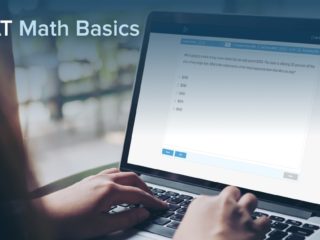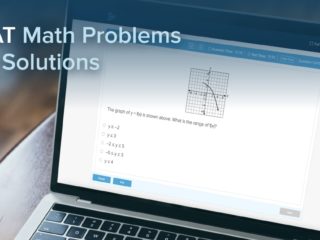| Getting your Trinity Audio player ready... |
Last Updated on July 4, 2024
If you’re new to the world of GMAT Focus, welcome! This article will provide you a complete GMAT Focus Math syllabus, to allow you to discover, in one place, all the topics covered in the Quantitative Reasoning section, with examples. And if you’ve been around GMAT for a while, you’ll be able to see a summary of the changes in the math coverage from the legacy GMAT to the GMAT Focus. (You may be surprised to see that there are relatively few differences between the two!)
No matter what your current level — newbie or seasoned veteran — you know that GMAT Focus preparation will take a significant amount of time. To ensure efficient studying, you need every tool you can find. Thus, a great start is for you to have a GMAT Focus math syllabus. By knowing which math topics are covered in the GMAT math section, you can get a better understanding of the road you must travel during your prep. You’ll know what material to study and how much time it might take you to master the math that is tested on the GMAT Focus.
Here are the topics we’ll cover:
- Changes to the Math Section: GMAT Focus
- What Are the Common Question Types for GMAT Focus Math?
- Math Topics on the GMAT Focus
- Take a Topical Approach to Your Studying
- Summary
- What’s Next?
Let’s begin by reviewing the changes in the Quant section of the GMAT Focus.
Changes to the Math Section: GMAT Focus
The fundamental purpose of the GMAT Focus is no different from that of the legacy GMAT. GMAC, the owner and administrator of the exam, states this about the exam: “Designed by business schools for business schools, the GMAT™ exam assesses the skills most relevant to success in a graduate management program.” With this in mind, we can understand why there are few changes from the prior Quant syllabus and the current one. Let’s look at those now.
- The number of questions in the Quantitative Reasoning Section has been reduced from 31 to 21, and the section time has been reduced from 62 minutes to 45 minutes.
- The math section no longer contains Data Sufficiency (DS) questions. All 21 math questions are Problem-Solving (PS) questions, which are traditional multiple-choice questions with 5 answer choices.
- Data Sufficiency questions are now included as one of the 5 question types in the Data Insights section of the GMAT Focus
- A burning question by many students is this: “Is there geometry on GMAT Focus?” The good news (for many) is that geometry is a topic that is no longer tested in the math section.
- The “question review and edit” option is a feature available in each of the 3 sections of the exam (Quant, Verbal, and Data Insights). Even though you must still answer every question in order, after you have finished answering all questions in the section, you may return to any questions you wish, and you may change the answers of up to 3 questions. Note that you must have sufficient time remaining in order to exercise this option.
Now that we have reviewed the changes to the Quant section of the GMAT Focus, let’s discuss the types of questions you will see in the Quant section.
What Are the Common Question Types for GMAT Focus Math?
The GMAT Focus Quantitative Reasoning section presents you with 21 multiple-choice questions, referred to as Problem-Solving (PS) problems. PS questions present you with 5 answer choices, one of which is correct. These questions are similar to the standard multiple-choice questions that you encountered in high school or on many standardized tests.
KEY FACT:
All 21 questions on the GMAT Focus Quant section are traditional multiple-choice questions with 5 answer choices.
Let’s first practice a basic PS question.
Example 1: PS Question – Traditional Multiple-choice
Given x^2 – 10x + 16 = 0, which of the following is equivalent to the equation?
- (x – 8)(x – 2) = 0
- (x – 8)(x + 2) = 0
- x(x – 8)(x + 2) = 0
- (x + 8)(x + 2) = 0
- x(x + 8)(x + 2) = 0
Solution:
We use the general form of a quadratic equation: ax^2 + bx + c = 0, and we see that a = 1, b = -10, and c = 16. To factor the equation, we want to find two numbers whose sum is -10 and whose product is 16. If we test some pairs of factors of 16, we see that -8 and -2 satisfy the two criteria:
Product = (-8) x (-2) = 16
Sum = -8 + -2 = -10
Using these two numbers, the quadratic equation can be factored as:
(x – 8)(x – 2) = 0
Answer: A
Another type of PS question that you might encounter presents you with three numbered statements, and you must identify which one(s) are correct. Let’s look at an example.
Example 2: PS Question: Three Numbered Statements
If m and n are integers and mn + n^2 is odd, which of the following must be odd?
- mn
- n^2 + m
- m^2n
- I only
- II only
- I and II only
- I and III only
- I, II, and III
Solution:
Let’s first review some even/odd rules:
odd x odd = odd odd x even = even even x even = even
odd + odd = even odd + even = odd even + even = even
If we factor mn + n^2, we get n(m + n). We are told that mn + n^2 is odd, so the product n(m + n) will also be odd. From the rules above, we see that odd x odd = odd. Thus, we know that n must be odd and (m + n) must also be odd.
Let’s look at (n + m) by itself. We already know that n is odd, and we know that (n + m) is also odd. From the rules summarized above, we note that (odd + even) = odd, so we know that m must be even.
To review:
1) n is odd
2) (n + m) is odd
3) m is even
Let’s now consider each numbered statement.
Statement I: mn
We know that m is even and n is odd. Since even x odd = even, we see that Statement I is not true.
Statement II: n^2 + m
We see that n^2 is odd x odd = odd, and we know that m is even. Thus, n^2 + m = odd + even = odd. Statement II is true.
Statement III: m^2n
Since m is even, then m^2 = even. Since n is odd, then m^2n = even x odd = even. Statement III is not true.
Answer: B
Math Topics on the GMAT Focus
There are roughly 20 major GMAT Focus Quant topics. The GMAT math syllabus breakdown of the major topics and their subtopics is given here:
- Basic Arithmetic: fractions; decimals; estimation; PEMDAS, factorials
- Linear Equations: solving one- and two-variable linear equations; solving systems of linear equations using the substitution method or the combination method; solving for one variable in terms of another variable
- Quadratic Equations: FOILing and factoring; quadratic identities; the zero-product property; solving equations containing fractional expressions
- Exponents and Roots: multiplying and dividing exponential expressions; addition and subtraction of exponents and roots; rationalizing the denominator; perfect and non-perfect roots; fractional exponents; negative exponents; solving exponential equations
- Number Properties: Integers: even/odd and positive/negative; prime numbers; least common multiple and greatest common factor; remainder theory; divisibility; evenly spaced sets; patterns in units digits
- Inequalities: differences between equations and inequalities; adding and subtracting inequalities; multiplication of an inequality by a negative number; compound inequalities
- Absolute Value: basics of absolute value; solving equations with absolute value; solving when two absolute value expressions are equal to each other
- General Word Problems: general word problems about money, age, mixtures, and consecutive integers; business-oriented word problems about salary, simple interest, compound interest, and profit/loss; linear versus exponential growth questions
- Rates: basic rate questions; average rates; converging or diverging rates; catch-up rates; catch-up and pass rates; round trip rates
- Work: basic work problems; combined worker questions; opposing worker questions
- Unit Conversions: basic unit conversions; conversions with squared or cubed units
- Ratios and Proportions: two-part ratios; three-part ratios; the ratio multiplier; setting up and solving proportion problems
- Percents: basic percents; percent of; percent less than or greater than; percent change
- Overlapping Sets: the set matrix; calculations using the set matrix; the Venn diagram
- Statistics: calculate mean, median, mode; weighted average; evenly spaced sets; range and standard deviation
- Combinations and Permutations: combination formula; fundamental counting principle; restricted and non-restricted combinations; permutation formula; indistinguishable permutations; circular permutation formula; code creation
- Probability: basic probability rules; mutually exclusive events and the addition rule; independent events and the multiplication rule
- Coordinate Geometry: axes; slope and y-intercept; parallel and perpendicular lines; distance formula; midpoint formula; circles; graphing inequalities in the coordinate plane
- Functions and Sequences; function notation; domain and range; compound functions; graphing functions; function word problems; arithmetic and geometric sequences
This list contains all the GMAT math topics and most of the subtopics you can expect to see on the GMAT Focus. Even though the exam asks only 21 Quant questions, you don’t know which topics you’ll encounter on test day, so you need to master each of them.
KEY FACT:
There are 20 major GMAT Focus math topics and many subtopics.
Take a Topical Approach to Your Studying
From the list just provided, you see that there is a vast amount of material you must learn. A great way to learn so much content is to learn one topic at a time and answer practice questions on only that topic until you have achieved mastery.
Some students begin their GMAT studying by buying a prep book. They open it and start answering questions on the practice tests. Their misguided thinking is that they should start their prep by simply learning the answers to the questions they have missed. Unfortunately, they learn out of context. They might learn how to answer the question they missed, but they probably cannot apply that piece of information to any body of knowledge. They quickly find that no real learning takes place if they jump from percentages to linear equations to probability in a 15-minute time span.
To truly learn GMAT Quant and get a great score, you must take time, effort, and care, focusing on just one topic until it’s mastered. Topical learning has been shown to be the most effective learning strategy for mastering the vast amount of material on the GMAT Focus math section.
To illustrate topical learning, let’s consider rates. First, you will learn about all the rates subtopics, such as average rates, converging rates, catch-up rates, and catch-up and pass rates, to name a few. Once you have those topics mastered, you will practice just rates questions. After so much focused learning and practice, you should be able to crush any question about rates that comes your way on test day. You can learn more about topical learning at our TTP GMAT self-study course.
TTP PRO TIP:
Using a topical study approach is a fantastic way to master GMAT Quant.
Summary
There are 3 major changes to the GMAT Focus, compared to the legacy GMAT. First, geometry is no longer tested. Second, the length of the Quant section has been reduced from 31 questions in 62 minutes to 21 questions in 45 minutes. Third, the Data Sufficiency (DS) question type no longer appears in the Quant section; it has been moved to the Data
Insights section of the exam.
A useful feature of the GMT Focus is that you can change answers in each section. After you have answered all questions in a section, you may revisit any question(s) and change up to 3 answers, time permitting.
There are roughly 20 main Quant topics that comprise the syllabus for GMAT Quant, and each topic has many subtopics. Because you don’t know which topics or subtopics will be tested, it’s necessary to master each one. The topics range from basic arithmetic to coordinate geometry to statistics, so you see that there is a wide variety of topics that you must master.
A proven strategy for mastering such a huge amount of material is topical learning, which involves immersion in just one topic at a time.
What’s Next?
This article has provided you with a comprehensive GMAT exam syllabus for the math section. Learning more about the GMAT Quant syllabus or practicing some basic GMAT Focus math problems will enhance your learning.



